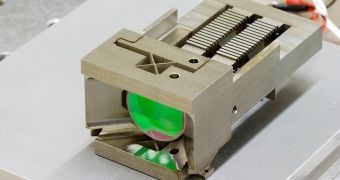The upcoming LISA mission that will be launched this decade finally got one of its most important components, the laser control system that will connect the three satellites in the program over millions of kilometers of space.
The Laser Interferometer Space Antenna (LISA) is a project that will see the launch of three identical spacecraft, which will fly in an equilateral triangle-shaped formation. Each individual component will be separated from the other by 5 million kilometers of empty space.
An advanced laser system is the key to enabling this mission to fulfill its objectives. Experts say that the light beams will connect the three satellites in a way that will enable them to remain in constant contact with each other.
LISA is currently being developed by the European Space Agency (ESA) in collaboration with NASA, and experts at both agencies have worked really hard to make the laser guidance system a reality.
The entire setup needs to be tremendously precise. The instrument will in essence be hunting gravitational waves, structures predicted by Albert Einstein's theory of general relativity.
These are ripples in the fabric of spacetime, and the theory goes that they are produced by black holes and other highly-dense objects. This is why the three spacecraft are placed so far apart.
Each of them contains a free-floating metal cube inside a special container. If a wave passes by one of the satellites, then its position will be slightly changed in regards to the other two.
The lasers are developed in such a manner that they can detect location variations of infinitesimal scale.
In order to produce the laser steering system, ESA decided to fund two promising research leads, one proposed by the TNO industrial group, in the Netherlands, and the other by the RUAG-CSEM collaboration, in Switzerland.
“ESA doesn’t duplicate technology development but does sometimes pursue complementary approaches. If one proves inadequate then we have another as backup,” says Lucio Scolamiero.
“Both developments are fully compliant to our extreme performance requirements,” adds the expert, who is in charge of overseeing some of the LISA-related developments for ESA.
He adds that most of the new technologies planned for the satellite array will be validated on the LISA Pathfinder spacecraft, which is scheduled to launch in 2013.

 14 DAY TRIAL //
14 DAY TRIAL //